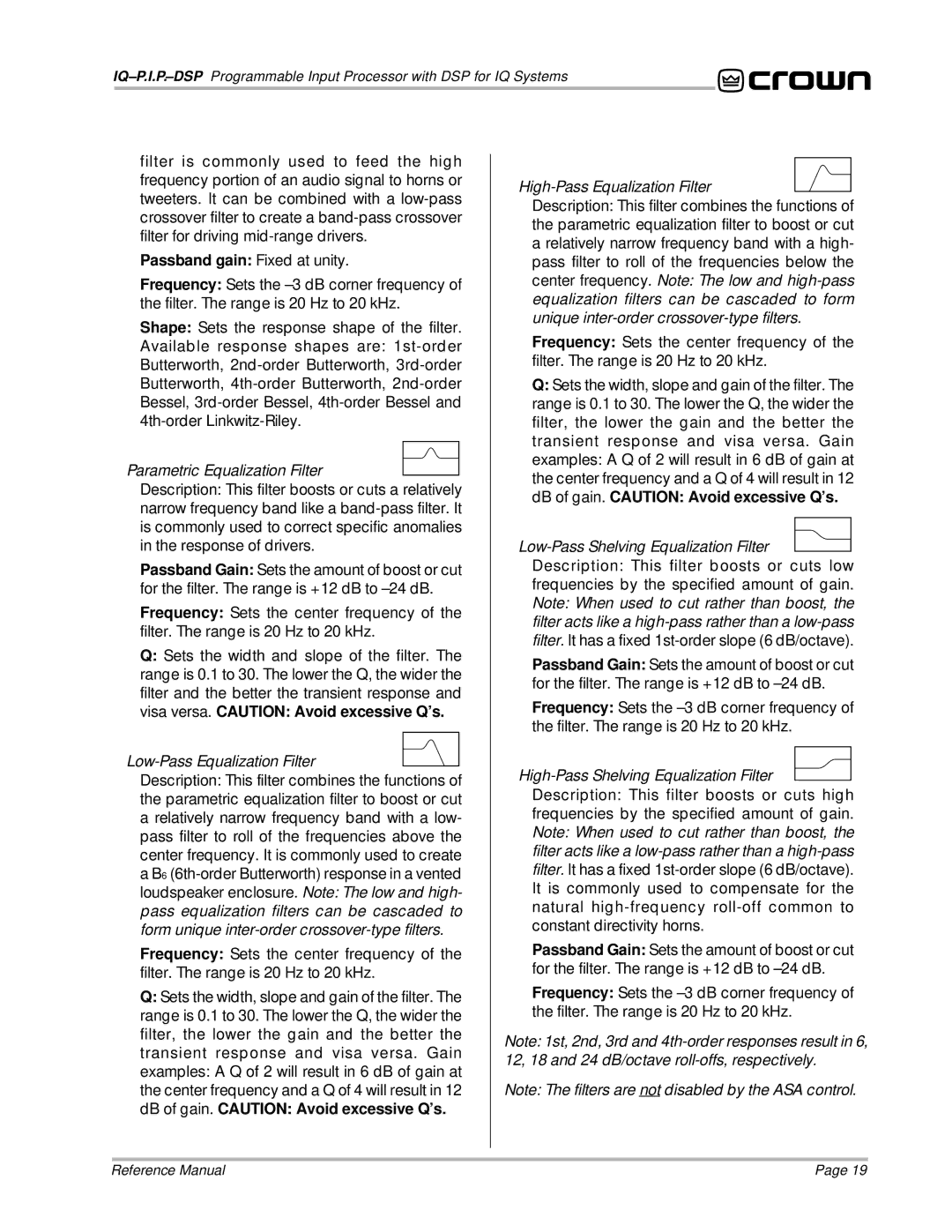
filter is commonly used to feed the high frequency portion of an audio signal to horns or tweeters. It can be combined with a
Passband gain: Fixed at unity.
Frequency: Sets the
Shape: Sets the response shape of the filter.
Available response shapes are:
Parametric Equalization Filter ![]()
![]() Description: This filter boosts or cuts a relatively narrow frequency band like a
Description: This filter boosts or cuts a relatively narrow frequency band like a
Passband Gain: Sets the amount of boost or cut for the filter. The range is +12 dB to
Frequency: Sets the center frequency of the filter. The range is 20 Hz to 20 kHz.
Q:Sets the width and slope of the filter. The range is 0.1 to 30. The lower the Q, the wider the filter and the better the transient response and visa versa. CAUTION: Avoid excessive Q’s.
![]()
![]() Description: This filter combines the functions of the parametric equalization filter to boost or cut a relatively narrow frequency band with a low- pass filter to roll of the frequencies above the center frequency. It is commonly used to create a B6
Description: This filter combines the functions of the parametric equalization filter to boost or cut a relatively narrow frequency band with a low- pass filter to roll of the frequencies above the center frequency. It is commonly used to create a B6
Frequency: Sets the center frequency of the filter. The range is 20 Hz to 20 kHz.
Q:Sets the width, slope and gain of the filter. The range is 0.1 to 30. The lower the Q, the wider the filter, the lower the gain and the better the transient response and visa versa. Gain examples: A Q of 2 will result in 6 dB of gain at the center frequency and a Q of 4 will result in 12 dB of gain. CAUTION: Avoid excessive Q’s.
![]()
![]() Description: This filter combines the functions of the parametric equalization filter to boost or cut a relatively narrow frequency band with a high- pass filter to roll of the frequencies below the center frequency. Note: The low and
Description: This filter combines the functions of the parametric equalization filter to boost or cut a relatively narrow frequency band with a high- pass filter to roll of the frequencies below the center frequency. Note: The low and
Frequency: Sets the center frequency of the filter. The range is 20 Hz to 20 kHz.
Q:Sets the width, slope and gain of the filter. The range is 0.1 to 30. The lower the Q, the wider the filter, the lower the gain and the better the transient response and visa versa. Gain examples: A Q of 2 will result in 6 dB of gain at the center frequency and a Q of 4 will result in 12 dB of gain. CAUTION: Avoid excessive Q’s.
![]()
![]() Description: This filter boosts or cuts low frequencies by the specified amount of gain. Note: When used to cut rather than boost, the filter acts like a
Description: This filter boosts or cuts low frequencies by the specified amount of gain. Note: When used to cut rather than boost, the filter acts like a
Passband Gain: Sets the amount of boost or cut for the filter. The range is +12 dB to
Frequency: Sets the
![]()
![]() Description: This filter boosts or cuts high frequencies by the specified amount of gain. Note: When used to cut rather than boost, the filter acts like a
Description: This filter boosts or cuts high frequencies by the specified amount of gain. Note: When used to cut rather than boost, the filter acts like a
Passband Gain: Sets the amount of boost or cut for the filter. The range is +12 dB to
Frequency: Sets the
Note: 1st, 2nd, 3rd and
Note: The filters are not disabled by the ASA control.
Reference Manual | Page 19 |
